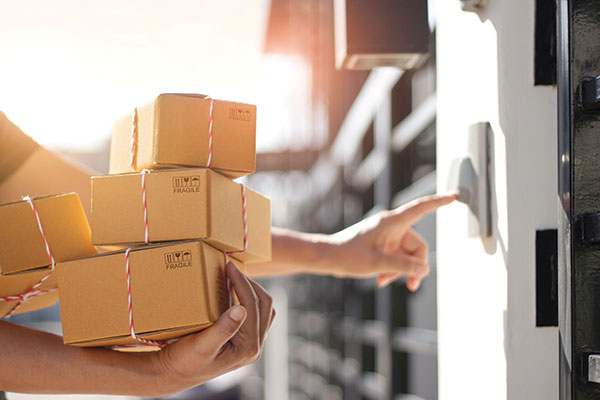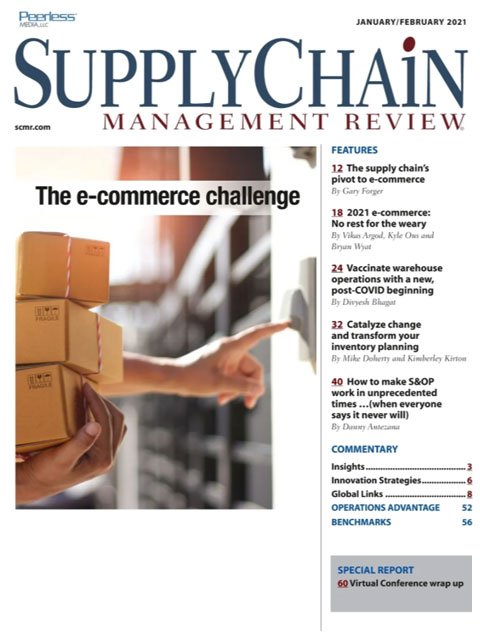Sorry, but your login has failed. Please recheck your login information and resubmit. If your subscription has expired, renew here.
January-February 2021
This morning, I turned on the television and watched the first stretch-wrapped pallets of the just-authorized vaccine being loaded onto a truck at a Pfizer plant in Michigan. From there, the pallets were headed to FedEx’s logistics hub in Memphis where they would be delivered to 153 locations across the 50 states. The event was both historic and mundane: Historic in that the shipments represent the hope of a nation that in the coming months, we’ll begin to put 2020—and COVID—in the rearview mirror; mundane in that this is a scene repeated millions of times a day, without fanfare, in plants and distribution centers across the country. Two of… Browse this issue archive.Need Help? Contact customer service 847-559-7581 More options
Everybody knew it was coming. No one knew exactly when. Until it arrived. All at once.
The “it,” of course, is explosive growth in e-commerce sales. And the “all at once” was the second quarter of 2020.
That’s when e-commerce sales soared 44.5% compared to the second quarter of 2019, according to the U.S. Department of Commerce. Not the 14% to16% expected for the year, which is anything but casual growth. And that accelerated pace fell off just 1% in the third quarter.
“How does any DC absorb that?” asks Dan Gilmore, vice president of marketing for Softeon. That, unfortunately, is not a rhetorical question. And the immediate answer is not easily, and certainly not gracefully. Worse yet, it was just a prelude of what was to come.
By the time Cyber Monday rolled around, e-commerce set a record for its biggest day ever—$10.8 billion, according to Adobe. That was on top of a more than 20% increase in e-commerce to $5 billion on Thanksgiving just a few days earlier. Talk about crushing a sense of order and control in DCs from coast to coast.
Unfortunately, the fallout didn’t stop at the shipping dock. It moved right onto parcel trucks.
Just 36 hours after Cyber Monday, CNBC reported that UPS had stopped picking up parcels from Nike, Gap, Macy’s, L.L. Bean, Hot Topic and Newegg. All of those companies had reached their designated shipment level set by UPS. They were maxed out.
Even more unfortunately, maxed out is exactly what retailers had been working many months to avoid.
Due to the pandemic, Amazon pushed Prime Day from July to October. The e-tailer went so far as to call it the start of holiday shopping. Harley Finkelstein, CEO of Shopify, later said that COVID pushed Cyber Monday from being a single day to a three-month season.
Retailers of every size were doing their best to find ways to spread out the holiday shopping season. Customers climbing over each other to get into stores at midnight of Black Friday was not an option. Retailers also needed to do the supply chain equivalent of socially distancing orders at their DCs in hopes that they could pick, pack and ship them in a timely fashion. And they needed to do it for both their employees and customers.
While the midnight crush was replaced by a 50% drop in store foot traffic on Black Friday, there was a corresponding 50% increase in curbside pickup of online orders out in the parking lot. That moved, at least in part, some online order fulfillment from DCs to stores. But curbside pickup didn’t exactly make DCs or parcel shipping significantly less chaotic. And there were still 22 shopping days left until Christmas.

This complete article is available to subscribers only.
Log in now for full access or start your PLUS+ subscription for instant access.
SC
MR
Sorry, but your login has failed. Please recheck your login information and resubmit. If your subscription has expired, renew here.
January-February 2021
This morning, I turned on the television and watched the first stretch-wrapped pallets of the just-authorized vaccine being loaded onto a truck at a Pfizer plant in Michigan. From there, the pallets were headed to… Browse this issue archive. Access your online digital edition. Download a PDF file of the January-February 2021 issue.Everybody knew it was coming. No one knew exactly when. Until it arrived. All at once.
The “it,” of course, is explosive growth in e-commerce sales. And the “all at once” was the second quarter of 2020.
That’s when e-commerce sales soared 44.5% compared to the second quarter of 2019, according to the U.S. Department of Commerce. Not the 14% to16% expected for the year, which is anything but casual growth. And that accelerated pace fell off just 1% in the third quarter.
“How does any DC absorb that?” asks Dan Gilmore, vice president of marketing for Softeon. That, unfortunately, is not a rhetorical question. And the immediate answer is not easily, and certainly not gracefully. Worse yet, it was just a prelude of what was to come.
By the time Cyber Monday rolled around, e-commerce set a record for its biggest day ever—$10.8 billion, according to Adobe. That was on top of a more than 20% increase in e-commerce to $5 billion on Thanksgiving just a few days earlier. Talk about crushing a sense of order and control in DCs from coast to coast.
Unfortunately, the fallout didn’t stop at the shipping dock. It moved right onto parcel trucks.
Just 36 hours after Cyber Monday, CNBC reported that UPS had stopped picking up parcels from Nike, Gap, Macy’s, L.L. Bean, Hot Topic and Newegg. All of those companies had reached their designated shipment level set by UPS. They were maxed out.
Even more unfortunately, maxed out is exactly what retailers had been working many months to avoid.
Due to the pandemic, Amazon pushed Prime Day from July to October. The e-tailer went so far as to call it the start of holiday shopping. Harley Finkelstein, CEO of Shopify, later said that COVID pushed Cyber Monday from being a single day to a three-month season.
Retailers of every size were doing their best to find ways to spread out the holiday shopping season. Customers climbing over each other to get into stores at midnight of Black Friday was not an option. Retailers also needed to do the supply chain equivalent of socially distancing orders at their DCs in hopes that they could pick, pack and ship them in a timely fashion. And they needed to do it for both their employees and customers.
While the midnight crush was replaced by a 50% drop in store foot traffic on Black Friday, there was a corresponding 50% increase in curbside pickup of online orders out in the parking lot. That moved, at least in part, some online order fulfillment from DCs to stores. But curbside pickup didn’t exactly make DCs or parcel shipping significantly less chaotic. And there were still 22 shopping days left until Christmas.
 SUBSCRIBERS: Click here to download PDF of the full article.
SUBSCRIBERS: Click here to download PDF of the full article.
SC
MR


More 3PL
- Services sector sees growth in October, reports ISM
- Managing inbound freight: What has changed in two decades?
- Inbound freight: Often a missed opportunity
- 2024 Warehouse/DC Operations Survey: Technology adoption on the rise
- Looking back at NextGen 2024
- Manufacturing again contracts in October, reports ISM
- More 3PL
Latest Podcast

 Explore
Explore
Business Management News
- The hard job of teaching soft skills
- Trump picks former Wisconsin congressman Sean Duffy for DOT secretary
- Made in Mexico, manufactured by China
- Retail sales see gains in October, reports Commerce and NRF
- Balancing green and speed: Home delivery insights from the pandemic era
- AdventHealth named top healthcare supply chain by Gartner
- More Business Management
Latest Business Management Resources

Subscribe

Supply Chain Management Review delivers the best industry content.

Editors’ Picks





